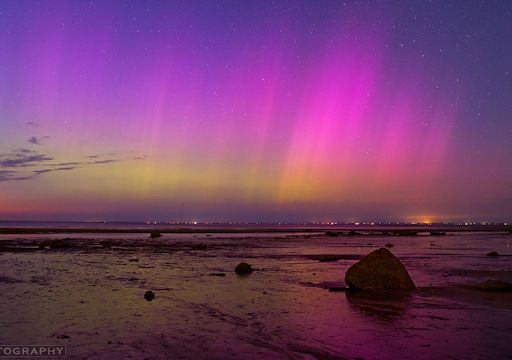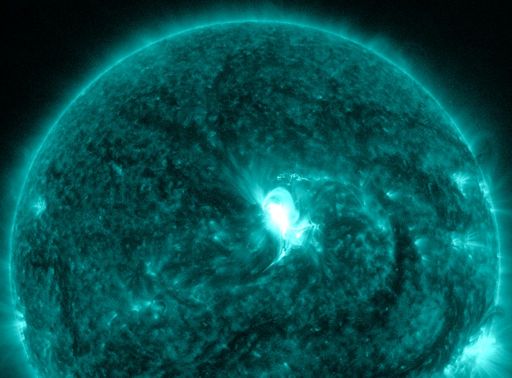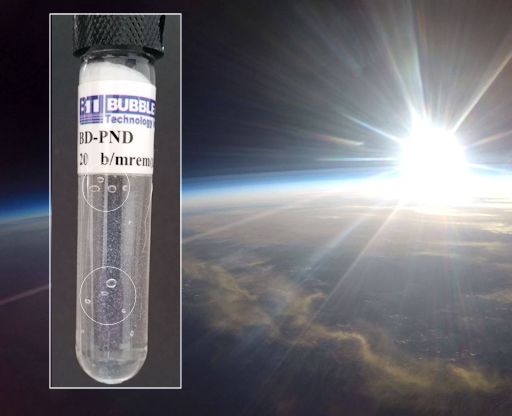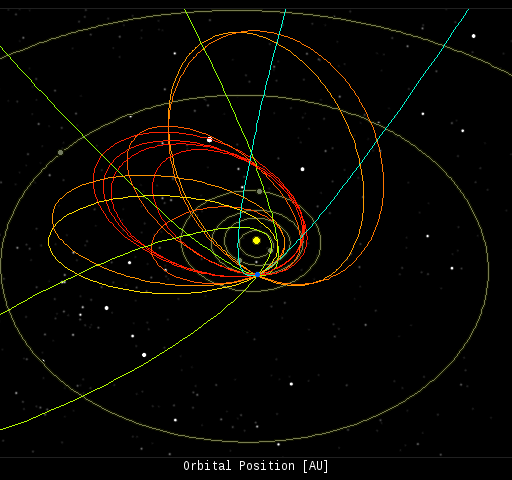Learn to photograph Northern Lights like a pro. Sign up for Peter Rosen's Aurora Photo Courses in Abisko National Park, winner of the TripAdvisor Certificate of Excellence Award 2015. | | |
SOLSTICE GEOMAGNETIC STORM: A series of CMEs hit Earth's magnetic field on June 22nd, producing a severe G4-class geomagnetic storm. Northern Lights spilled across the Canadian border into more than a dozen US states, including places as far south as Colorado, Georgia, Virginia and Arkansas. "The auroras did not disappoint," says Chris Cook, who witnessed the display from Cape Cod, Massachusetts:

"They were visible in deep twilight!" he adds. "I positioned myself on a beach overlooking Cape Cod Bay so I could capture the reflection in the water at low tide."
More auroras are in the offing as Earth's magnetic field reverberates from the CME strikes. NOAA forecasters estimate a 90% chance of polar geomagnetic storms on June 23rd, subsiding only a little to 70% on June 24th. Aurora alerts: text, voice
Realtime Aurora Photo Gallery
MEANWHILE ... ANOTHER CME IS ON THE WAY: Big sunspot AR2371 erupted again on June 22nd (18:23 UT), producing a strong M6.5 class solar flare. NASA's Solar Dynamics Observatory recorded the extreme ultraviolet flash:

X-ray and UV radiation from the flare ionized the upper layers of Earth's atmosphere, causing a blackout of some shortwave radio signals over North America (blackout map). Mariners and ham radio operators, in particular, may have noticed disturbances at frequencies below ~20 MHz.
The explosion also hurled a full-halo CME directly toward Earth: movie. NOAA analysts are still modeling the storm cloud to estimate its likely time of arrival. Best guess: June 24th. Sky watchers should prepare for more geomagnetic stoms and auroras on Wednesday night. Solar flare alerts: text, voice
Realtime Space Weather Photo Gallery
NEUTRONS IN THE STRATOSPHERE: For nearly two years, Spaceweather.com and the students of Earth to Sky Calculus have been using helium balloons to monitor X-rays and gamma-rays in the stratosphere. Their successful program has detected multiple radiation events in response to solar storms. On June 18th they added something new. For the first time, the group's Space Weather Payload included a bubble chamber for measuring neutrons. The device flew 109,012 feet above California's Sierra Nevada mountain range, then parachuted back to Earth, landing near Death Valley National Park. The results: Neutrons were detected.

Circled above are some of the bubbles that formed as neutrons passed through the chamber. By counting the bubbles, it is possible to estimate the total dose of neutron radiation absorbed during the 3 hour flight. The answer is 600 microRads (energy range 200 keV - 15 MeV). Interestingly, this is almost the same dose detected by onboard X-ray and gamma-ray sensors: 620 microRads (energy range 10 keV to 20 MeV). Lesson: if you only count X-rays and gamma-rays, then you are missing at least half of the radiation in the atmosphere. Neutrons matter, too.
Indeed, neutrons are a very important form of cosmic radiation, providing much of the biologically effective radiation dose at altitudes of interest to aviation and space tourism. Low-energy neutrons also cause single-event upsets in aircraft avionics, especially devices that contain Boron 10. Adding a neutron sensor to the Space Weather Payload allows the students to monitor this type of radiation at altitudes ranging from ground level to 120,000 feet.
Realtime NLC Photo Gallery
Realtime Sprite Photo Gallery
Every night, a network of NASA all-sky cameras scans the skies above the United States for meteoritic fireballs. Automated software maintained by NASA's Meteoroid Environment Office calculates their orbits, velocity, penetration depth in Earth's atmosphere and many other characteristics. Daily results are presented here on Spaceweather.com.
On Jun. 23, 2015, the network reported 27 fireballs.
(27 sporadics)

In this diagram of the inner solar system, all of the fireball orbits intersect at a single point--Earth. The orbits are color-coded by velocity, from slow (red) to fast (blue). [Larger image] [movies]
Potentially Hazardous Asteroids (
PHAs) are space rocks larger than approximately 100m that can come closer to Earth than 0.05 AU. None of the known PHAs is on a collision course with our planet, although astronomers are finding
new ones all the time.
On June 23, 2015 there were 1592 potentially hazardous asteroids.
Notes: LD means "Lunar Distance." 1 LD = 384,401 km, the distance between Earth and the Moon. 1 LD also equals 0.00256 AU. MAG is the visual magnitude of the asteroid on the date of closest approach. | | The official U.S. government space weather bureau |
| | The first place to look for information about sundogs, pillars, rainbows and related phenomena. |
| | Researchers call it a "Hubble for the sun." SDO is the most advanced solar observatory ever. |
| | 3D views of the sun from NASA's Solar and Terrestrial Relations Observatory |
| | Realtime and archival images of the Sun from SOHO. |
| | from the NOAA Space Environment Center |
| | the underlying science of space weather |
| | Web-based high school science course with free enrollment |

